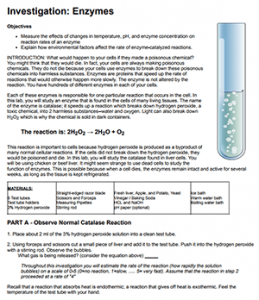
Have you ever noticed that when you pour hydrogen peroxide on a wound, it bubbles? The reason is that bacteria and your own tissue contains an enzyme that breaks down the peroxide. Peroxide splits into a molecule of water and a molecule of oxygen, which causes the bubbles. In a series of tests, students observe how the enzyme catalase breaks down hydrogen peroxide into oxygen and water. Simply place a few drops of peroxide onto tissue and the bubbling will indicate the presence of the enzyme, catalase.
Catalase is found in living tissues, but a good reaction can be observed when using chicken livers. Reactions also occur other living tissues, like potatoes. The bubbling of the peroxide serves as a measure for how quickly the reaction takes place.
For example, when adding peroxide to liver, so the bubbles may even overflow the test tube. The reaction is dramatic and fun to watch. (Students should wear safety goggles!) You won’t see the reaction when peroxide is poured over salt or sugar, because these compounds do not contain catalase.
Students then determine how temperature and pH affects reaction rates by placing the liver in different water baths and adding acidic and basic solutions.
Each section requires students to gather data then complete a CER chart (claim, evidence, reasoning) to answer a guiding question.
Finally, students develop their own experiment to test the effects of lactose on milk sugar. Students can perform this activity in the lab or you can show them as a demo by using benedict’s solution or glucose food test trips.
Grade Level: 11-12 | *Time Required: 60-75 minutes
*Most of the data collection can be completed in a 50 minute class time, with the next class period for discussion and analysis
HS-LS1-1 Construct an explanation based on evidence for how the structure of DNA determines the structure of proteins which carry out the essential functions of life through systems of specialized cells

